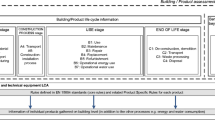Abstract
Purpose
Life cycle assessment (LCA) can reveal valuable information pertaining to materials, water, and energy that will be consumed throughout a building’s entire predicted life span; however, it is often underutilized in practice. Individuals in the architecture, engineering, and construction (AEC) community are in positions to influence the use of LCA. Thus, this article seeks to clarify the state of knowledge of LCA among this population and understand the perceived benefits of and barriers to its application.
Methods
Building upon the researchers’ results using focus groups, a national survey of AEC professionals, owners/clients, and related groups was developed to educe knowledge and perceptions within the AEC community. Existing literature suggests time and data demands, complexity, and cost to benefit ratio uncertainty among current LCA framework shortcomings. The survey was structured to further investigate these findings. Furthermore, the survey recorded both a self-assessed and measured level of each respondent’s LCA understanding, which served as a validation for other responses. The information collected spanned a broad range, including LCA knowledge, LCA experience, perceived benefits and barriers to LCA adoption, software tool utilization, and LCA in conjunction with sustainability, in general, and with the Leadership in Energy and Environmental Design (LEED) program.
Results and discussion
Respondents represented over a dozen AEC professions, approximately half being architects and engineers. Ninety percent reported having at least moderate familiarity with sustainability, and 62 % considered sustainability important in their projects for at least 4 years. Only 33 % of those individuals, however, used LCA in half of their projects or more, predominantly for energy analysis. A substantial percentage of respondents exhibited competency in defining LCA, but the disconnect between awareness and the use of LCA can be largely attributed to a perceived lack of demand. However, 86 % of respondents who currently use LCA reported being at least moderately likely to increase their usage of LCA in the future.
Conclusions
The ability of an LCA to advance sustainability by informing decision-making and provide environmental impact information using a long-term, holistic perspective is valuable to most potential users. Additional benefits and barriers specific to the building sector were revealed in this study, and the factors that may contribute to these perceptions were explored, the knowledge of which can be beneficial in efforts to optimize LCA adoption. Finally, since Leadership in Energy and Environmental Design (LEED) version 4.0 explicitly includes LCA, we anticipate a greater integration and use of LCA in the AEC community.






Similar content being viewed by others
References
Bilec MM, Ries RJ, Matthews HS (2010) Life-cycle assessment modeling of construction processes for buildings. J Infrastruct Syst 16(3):199–205
Cooper JS, Fava JA (2006) Life-cycle assessment practitioner survey: summary of results. J Ind Ecol 10(4):12–14
Cooper J, Fava J, Baer S (2008) Life cycle assessments of buildings in North America. J Ind Ecol 12(1):7–9
Dillman DA (2007) Mail and Internet surveys: the tailored design method, 2nd edn. Wiley, Hoboken
U.S. Environmental Protection Agency (2009). Green Building Basic Information http://www.epa.gov/greenbuilding/pubs/about.htm. Accessed November 2014
Fowler FJ (2009) Survey research methods. SAGE Publications, Los Angeles, i.e. Thousand Oaks, Calif
Groves RM (2004) Survey methodology. Wiley, Hoboken
Guggemos AA, Horvath A (2005) Comparison of environmental effects of steel- and concrete-framed buildings. J Infrastruct Syst 11(2):93–101
Hauschild M, Wenzel H (1998) Environmental assessment of products. University Press, Cambridge, Great Britain
Hofstetter P, Mettier TM (2003) What users want and may need: insights from a survey of users of a life-cycle tool. J Ind Ecol 7(2):79–101
Junnila S (2008) Life cycle management of energy-consuming products in companies using IO-LCA. Int J Life Cycle Assess 13(5):432–439
Junnila S, Horvath A (2003) Life-cycle environmental effects of an office building. J Infrastruct Syst 9(4):157–166
Kubba S (2012) Handbook of green building design and construction LEED, BREEAM, and Green Globes. Elsevier, Amsterdam
Malmqvist T, Glaumann M, Scarpellini S, Zabalza I, Aranda A, Llera E, Díaz S (2011) Life cycle assessment in buildings: the ENSLIC simplified method and guidelines. Energy 36(4):1900–1907
Ochoa L, Hendrickson C, Matthews HC (2002) Economic input-output life-cycle assessment of U.S. residential buildings. J Infrastruct Syst 8(4):132–138
Rajagopalan N, Bilec M, Landis AE (2010) Residential life cycle assessment modeling: comparative case study of insulating concrete forms and traditional building materials. J Green Build 5(3):95–106
Saunders CL, Landis AE, Mecca LP, Jones AK, Schaefer LA, Bilec MM (2013) Analyzing the practice of life cycle assessment: focus on the building sector. J Ind Ecol 17(5):777–788
Scheuer C, Keoleian G, Reppe P (2003) Life cycle energy and environ performance of a new university building: modeling challenges and design implications. Energy Build 35:1049–1064
Sharrard AL, Matthews S, Reis R (2008) Estimating construction project environmental effects using an input-output-based hybrid life-cycle assessment model. J Infrastruct Syst 14(4):327–336
Stoop I, Billiet J et al (2010) Improving survey response lessons learned from the European Social Survey. Wiley, Chichester, West Sussex
U.S. Department of Energy (2011). 2010 Buildings Energy Data Book. http://buildingsdatabook.eren.doe.gov/. Accessed November 2014
Wagner LA (2002) Materials in the economy—material flows, scarcity, and the environment. U.S. Dept. of the Interior, U.S. Geological Survey, Denver
Acknowledgments
Research was funded by the National Science Foundation (grant award EFRI-1038139) and by a seed grant from the Mascaro Center for Sustainable Innovation at the University of Pittsburgh. Assistance with survey development, distribution, and data collection was provided by the University of Pittsburgh University Center for Social and Urban Research (UCSUR). The authors would like to thank the respondents to the survey for their effort, opinions, and insights.
Author information
Authors and Affiliations
Corresponding author
Additional information
Responsible editor: Guillaume Habert
Rights and permissions
About this article
Cite this article
Olinzock, M.A., Landis, A.E., Saunders, C.L. et al. Life cycle assessment use in the North American building community: summary of findings from a 2011/2012 survey. Int J Life Cycle Assess 20, 318–331 (2015). https://doi.org/10.1007/s11367-014-0834-y
Received:
Accepted:
Published:
Issue Date:
DOI: https://doi.org/10.1007/s11367-014-0834-y




